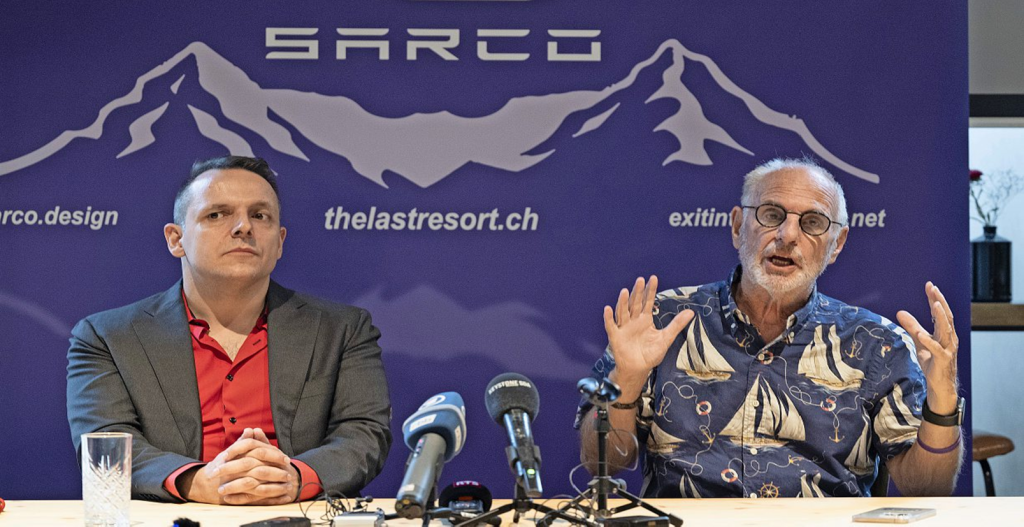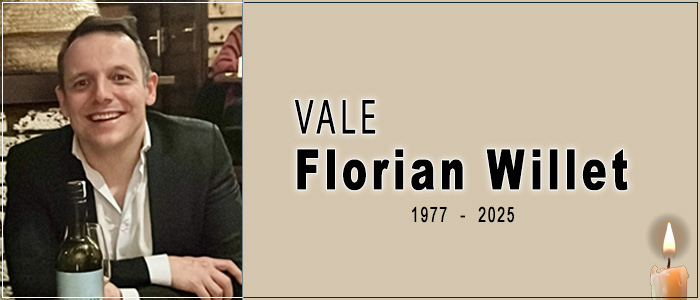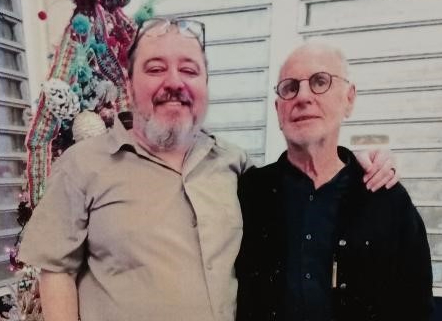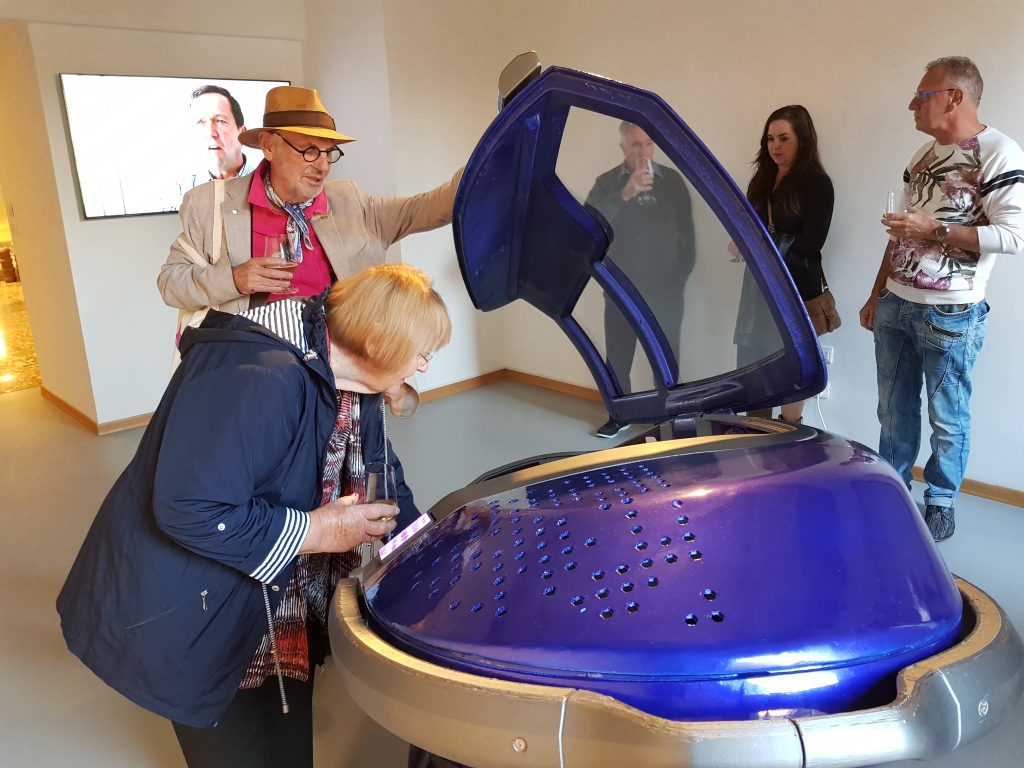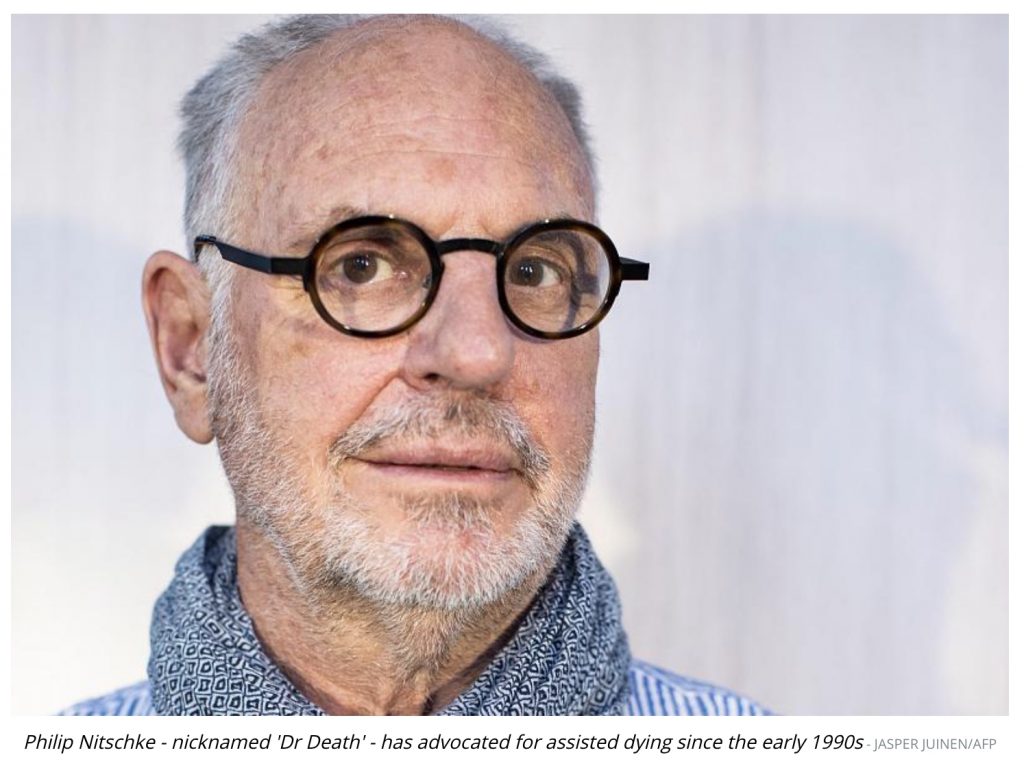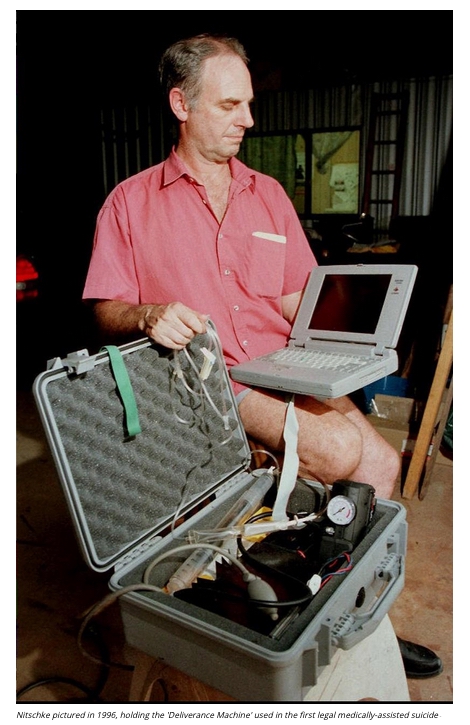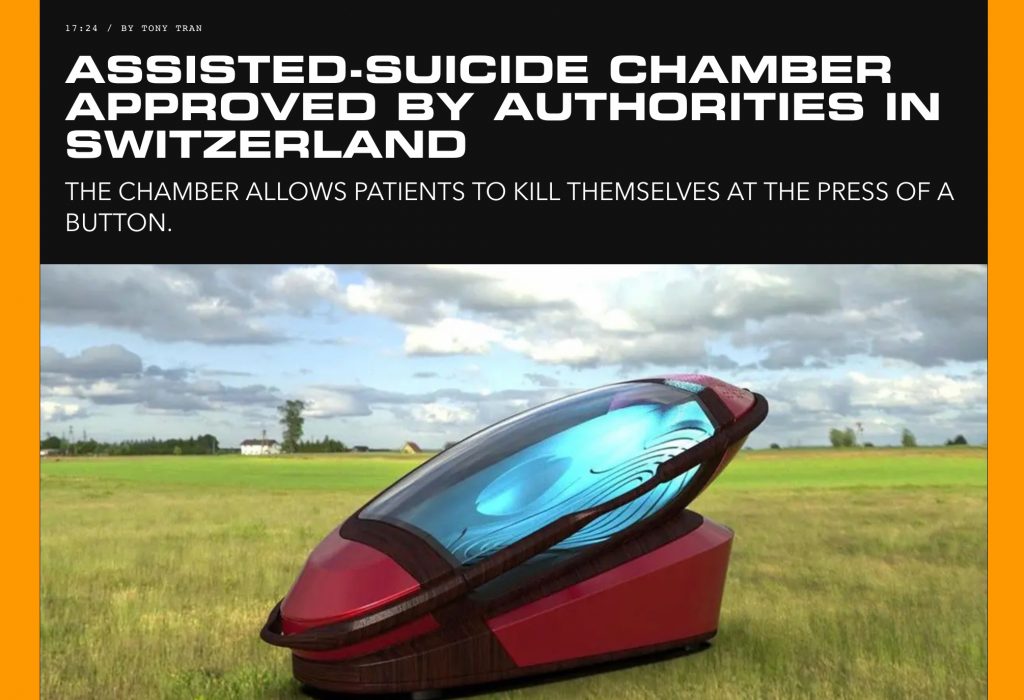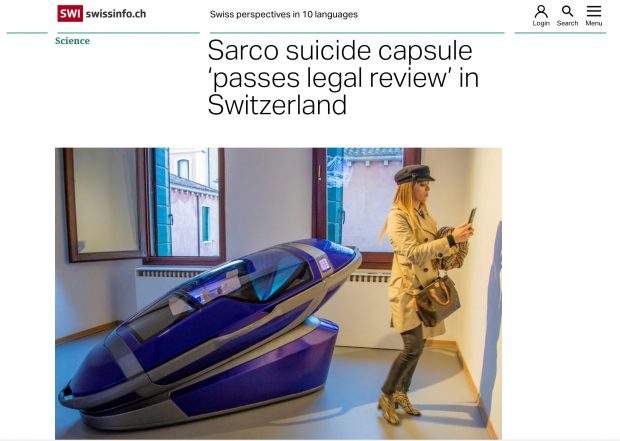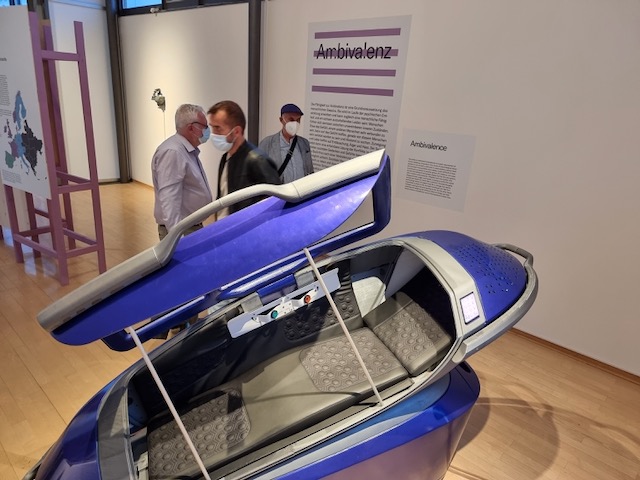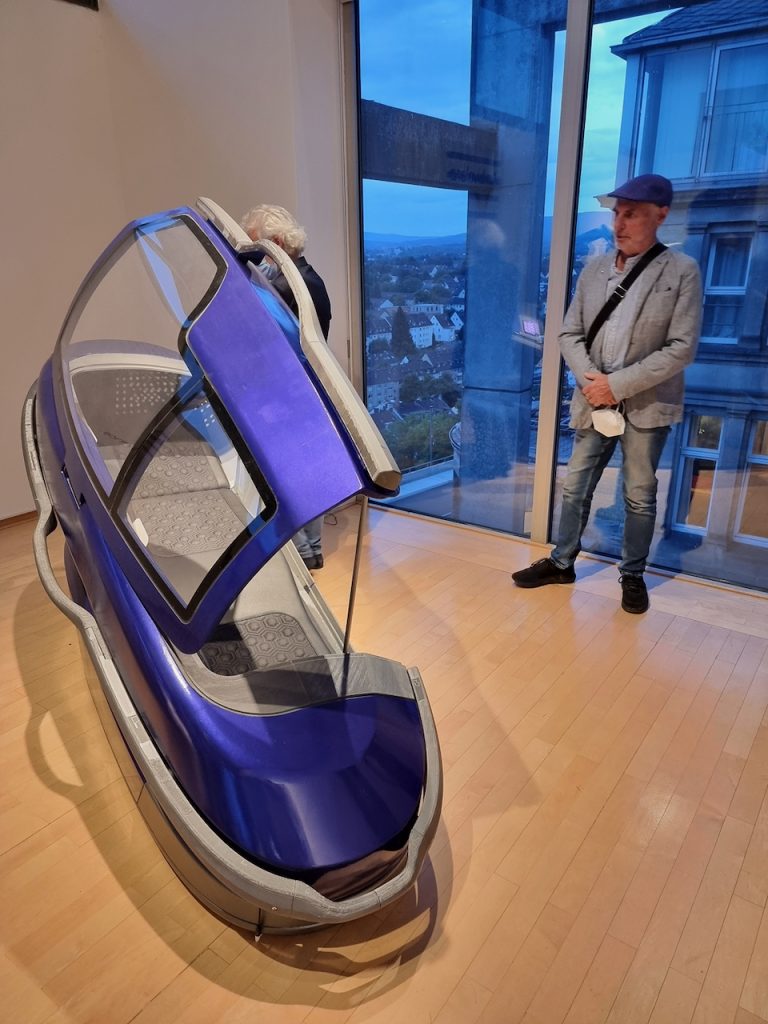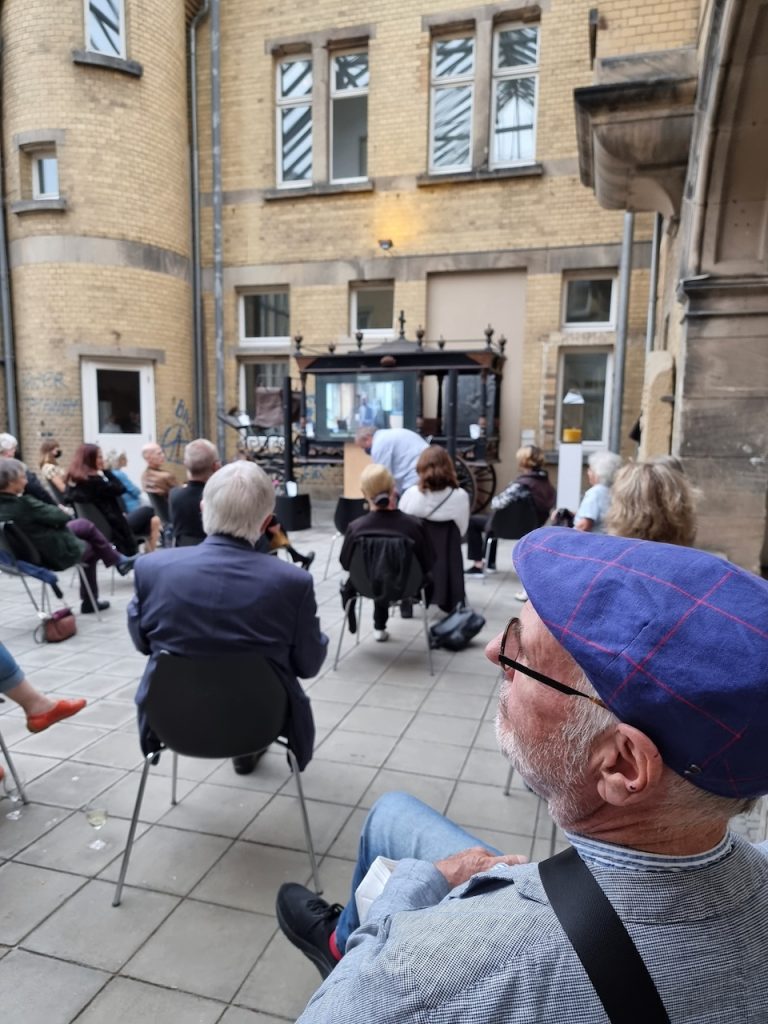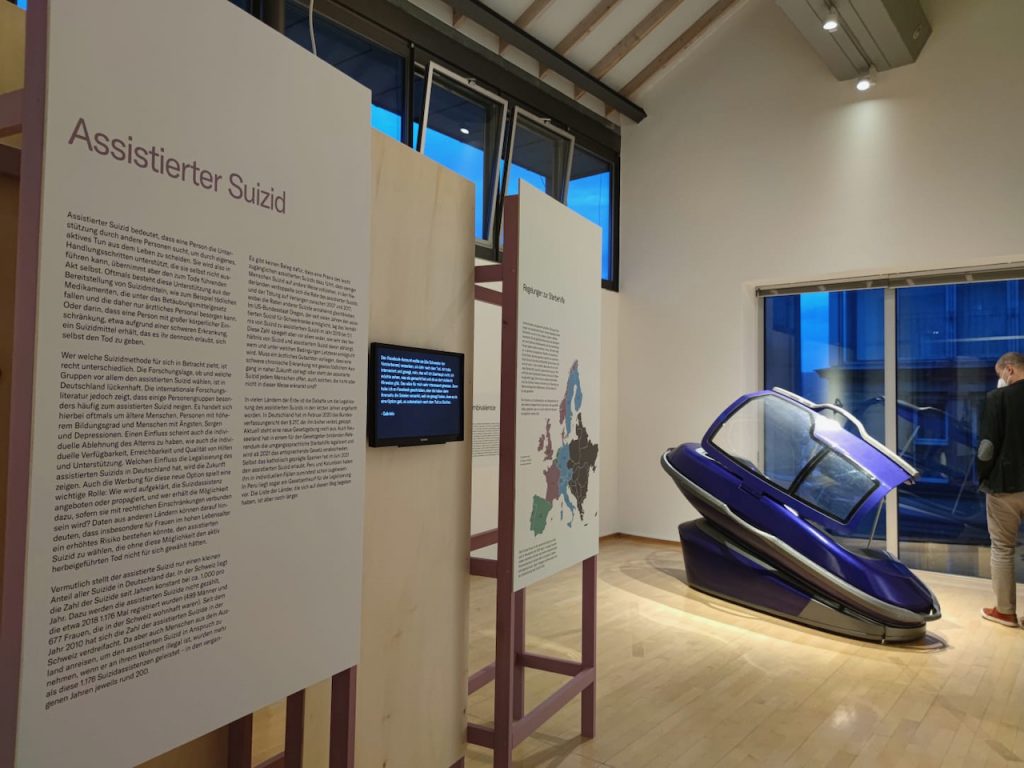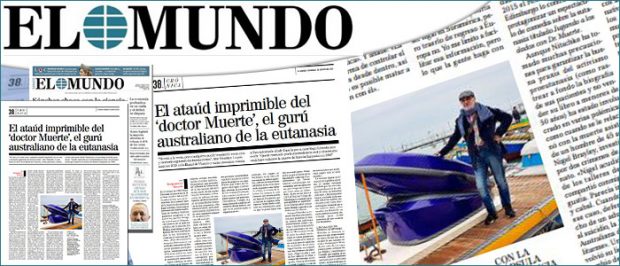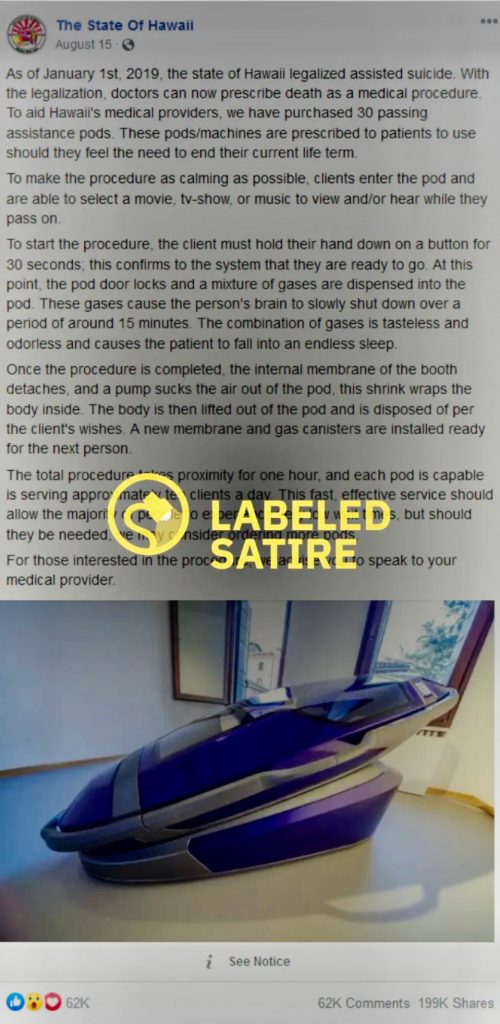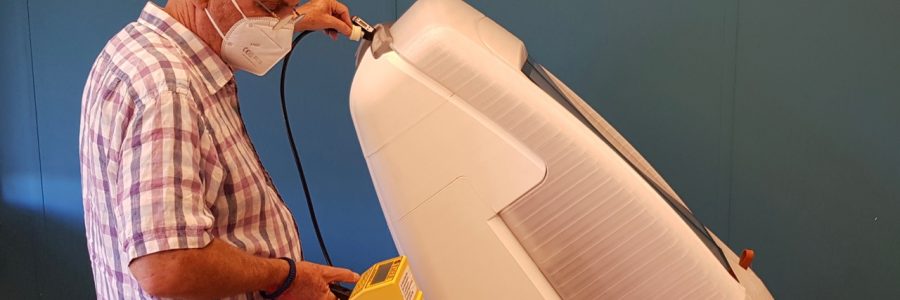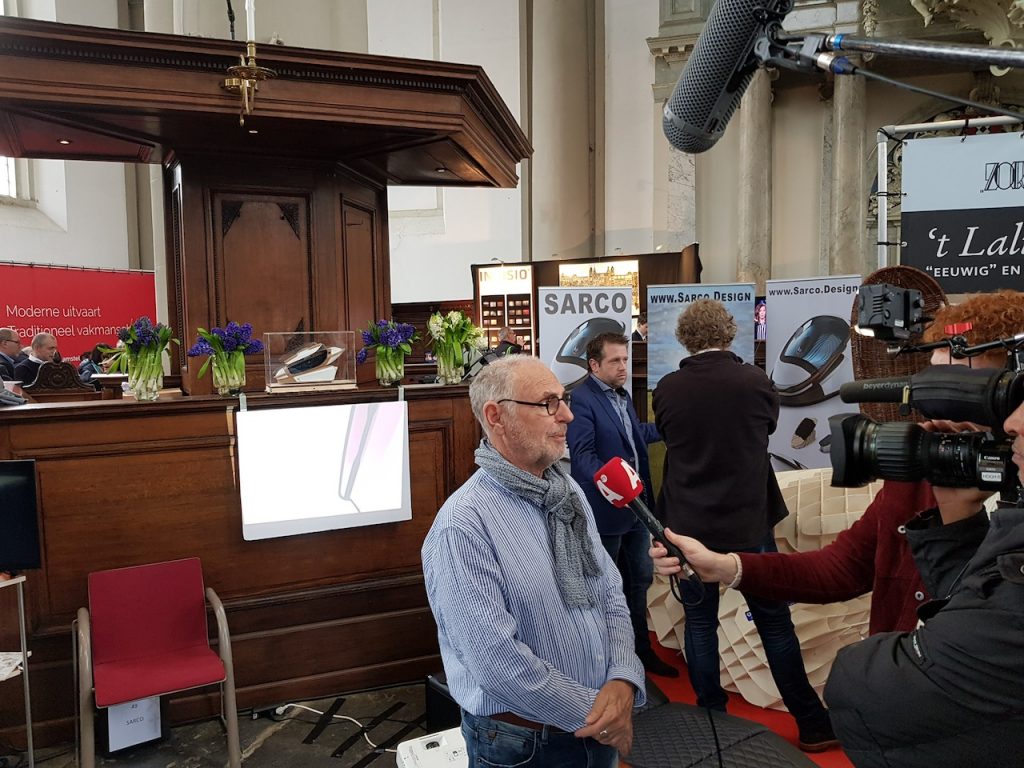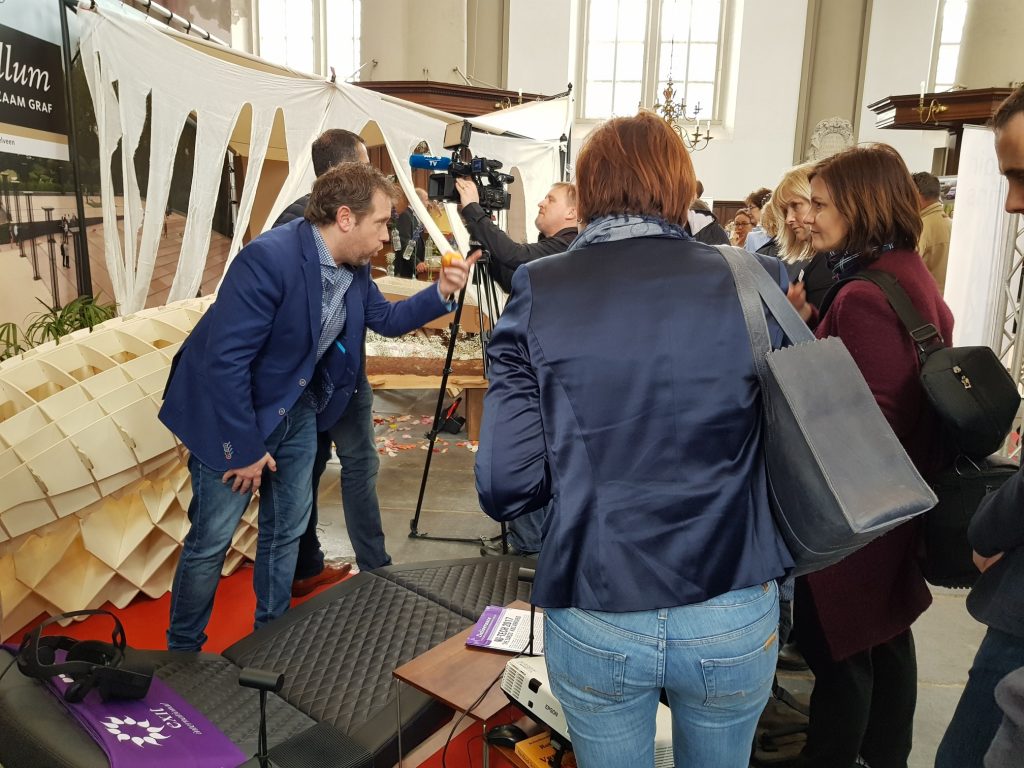In Switzerland, a 64-year-old woman passed away last month in a specially designed ‘suicide capsule.’
Swiss authorities subsequently arrested people involved and bystanders. What happened in the woods of Switzerland?
Reconstruction: The mists surrounding the Sarco by Door Maud Effting, Haro Kraak en Erik Verwiel for De Volkskrant newspaper. Fotografie Linelle Deunk en Veerle Haan
A reconstruction full of ethical dilemmas, political beliefs and legal conundrums.
Florian Willet wonders where they are. It has been almost an hour and a half since the authorities were called.
The 47-year-old German is standing on a dirt road in the woods near Schaffhausen, a Swiss canton bordering Germany.
It is Monday evening, September 23, and dusk is setting in. He waits, and he can only think of one thing.
Behind him in the woods lies a dead woman. Willet watched her die. He was the only one there.
The suicide capsule Sarco
Shortly after her death, around 4:40 PM, the two lawyers involved in the project informed the authorities. They are waiting further down the road.
The lawyers told the authorities that a 64-year-old American woman had taken her own life in the Sarco, a ‘suicide capsule’ working with gas.
They reported that the woman was assisted by The Last Resort, a new Swiss organization founded by human rights activists that provides assisted suicide. Willet is the president.
The question was whether the police would come to confirm the death of the woman, who is lying in the futuristic, purple capsule.
Willet feels relieved. He believes everything went well. The woman was calm, he will say later, everything went according to plan. “It was clear that she wanted this.” In a blue folder under his arm, he carries the money she left behind for her funeral expenses.
Most unusual treatment
A little after six pm, a Volkskrant photographer arrives at the location. The police are still not there, almost an hour and a half after the call.
But shortly thereafter, things move quickly. A convoy of police cars speeds up the Swiss hills, and officers detain everyone near the Sarco.
Willet, the two lawyers, and the Volkskrant photographer are locked up in police cells.
Later, they are transported to prisons.
The public prosecutor detains the lawyers and the photographer for 48 hours, which is highly unusual in Western, democratic countries when it comes to lawyers and journalists.
Moreover, the Swiss prosecutor places them in isolation – they are not allowed to communicate with the outside world – to prevent them from ‘conspiring.’
During interrogations, the four are told that they are all suspected of inciting suicide and providing assistance in doing so.
But the Swiss prosecutor also has another possible suspicion, which he has not yet disclosed to the public.
It’s a suspicion known in Switzerland as ‘vorsätzliche Tötung’, which is translated in English as intentional homicide.
Nitschke and Stewart
This is the story behind the Sarco, the suicide capsule that was recently used for the first time and – partly due to the arrests – became worldwide news.
The Sarco was conceived by the Australian doctor and physicist Philip Nitschke (77), an internationally known right to die advocate.
Twenty-seven years ago, he founded Exit International, a movement driven by ideals that now has 30,000 supporters.
His capsule operates via self-service: pressing a button fills the cabin with nitrogen gas and removes the oxygen.
This causes unconsciousness and subsequently leads to death by hypoxia, a lack of oxygen. According to Nitschke, this results in a “quick, peaceful and dignified death.”
The Sarco was developed in the Netherlands. Nitschke has lived there for ten years with his wife, lawyer Fiona Stewart (58). She is Dutch now, he is a permanent resident.
Yet they chose Switzerland as the location for Sarco’s first use. Switzerland is one of the few countries in the world where assisted suicide is allowed, provided it is done for altruistic reasons.
In the Netherlands, this is illegal. The Last Resort was established specifically for the Sarco in 2023: Nitschke is a technical advisor, and Stewart is a member of the advisory board.
The events in the Swiss canton raise questions about what happened behind the scenes.
How did those involved act?
What were their motives?
Why did the Swiss react so strongly to the Sarco, even deciding to detain lawyers and a journalist?
And why did they keep the suspicion of ‘intentional homicide’ hidden all this time?
And also: what is known about the way the woman died?
De Volkskrant has been investigating the case over the past months in the Netherlands and Switzerland, and is basing its findings on conversations with 25 individuals and experts involved, an audio recording, video footage, legal documents, on-site observations, emails and app messages.
May 2024
‘This is the nervous part’, Fiona Stewart says.
Today, Nitschke will test his machine live in a Rotterdam workshop by lying in it himself. About fifteen people are watching.
Among them are a few journalists and documentary makers. Nitschke, dressed in a bright pink blouse, looks focused and introspective.
The doctor, who once earned a PhD in physics with research on lasers, has worked for twelve years on his invention.
Just a few minutes ago, he was pouring liquid nitrogen of nearly -200 degrees Celsius. White vapors were filling the room. Now he is frantically checking various meters and graphs on his iPad. An assistant is trying to ensure the Sarco closes properly.
The Sarco is a deep purple color with silver glitter. Stewart: ‘Purple is the color of dignity. We spent months creating the right sparkle effect. It just had to be perfect.’
In the past, much to his wife’s horror, Nitschke once put a plastic bag over his head to test how quickly the oxygen would deplete. Now he subjects himself to this experiment with the Sarco.
It is certainly not without risk. Yet the doctor, looking fearless, straps an oxygen mask with elastic bands around his nose and mouth. He steps into his own capsule and pulls the lid shut. Click. There he lies, ready for the test.
The oxygen bottle rests on his lap.
In the workshop, everyone falls silent. ‘Is the oxygen on?’ Stewart asks.
Nitschke nods calmly from behind the perspex window.
Suddenly, the capsule fills with white mist—a sign that cold nitrogen is flowing in. The meters show the oxygen level plummeting.
Within sixty seconds, it drops from 20.9 to 0.4 percent; humans cannot survive below 10 percent.
Stewart rushes to the Sarco. ‘Are you all right?’ she asks. The stress is palpable.
Nitschke nods. Someone reads the time aloud. Three minutes without oxygen. Four. Five.
A little later, the cork pops off the bottle of prosecco.
It works. For the first time that day, Stewart looks relaxed. She laughs. ‘This is the real thing’, she says. ‘Cheers.’
Absolutely Free
When it comes to his ideals, Philip Nitschke is a man who goes all in. He is hard to restrain, his wife says. Nitschke stands for the idea that every person should be absolutely free to determine how they live their life. And thus also how they die.
In the late 1990s, he performed the world’s first legal euthanasia as a doctor in Australia. From that moment, he initiated several controversial projects. In 2006, he caused a worldwide stir with The Peaceful Pill Handbook, in which he detailed dozens of suicide methods. The book was banned in Australia.
“My vision is simple,” Nitschke said earlier in de Volkskrant. “Don’t keep people in the dark. In a healthy society, people get good information so they can make rational decisions.”
In the media, he has been nicknamed ‘Dr Death’.
After several suicides, police worldwide raided properties of Exit International and its elderly members, seizing phones, computers and lethal substances. And interrogating Nitschke for hours.
Demedicalize the process
The idea for the Sarco arose in 2012 when Nitschke received a request from Tony Nicklinson, a 58-year-old British man with locked-in syndrome, who had been paralyzed from the neck down for seven years.
Nicklinson described his existence as ‘a living nightmare’. His lawyers asked Nitschke if there was a way their client could die independently, without the help of any doctor.
‘He was so disabled that he couldn’t even jump off a bridge’, Nitschke says. ‘He could only blink his eyes. So I thought: can I design a machine that he can activate with his eyes?’
He made an initial design, looking like a bathtub with a lid. ‘I wanted to use gas’, he says.
‘Because then almost nothing was needed. No needles in arms, no doctors, no illegal drugs. I wanted to demedicalize the whole process.’
But for Nicklinson, it was already too late. After losing his court case to die with the help of a doctor, he did not want to wait any longer. He stopped eating and drinking.
‘But the idea stayed in my head’, says Nitschke.
The Sarco, short for sarcophagus, is a variant of suicide with a bag over the head. With this method, people inhale gas – helium, nitrogen – that flows into the bag through a tube. The gas itself is not toxic.
When asked about this, the Dutch Society of Anesthesiology (NVA) predicts that in this situation the brain will experience severe oxygen deprivation within a few breaths. Shortly thereafter, people will lose consciousness and pass away.
Likely, they will experience ‘no shortness of breath nor a feeling of suffocation’, the NVA says. According to Nitschke, in the first moments this can even cause brief euphoria, a state he calls ‘happy hypoxia’.
Nitschke: ‘People often told me: this looks like a wonderful way to die, but I hate the plastic bag. And that’s why I thought: how can we make a plastic bag look beautiful? How can I make it a bit more glamorous and stylish?”
Exceptional System
In the years he worked on the Sarco, it became increasingly clear to Nitschke that there was only one place where the capsule could be used for the first time: Switzerland.
Switzerland has an exceptional system for euthanasia worldwide, where self-determination is paramount. Active euthanasia, where a doctor ends a patient’s life, is considered ‘murder on request’ by law and is prohibited.
But since 1942, there has been an exception for assisted suicide. A doctor can, for example, prescribe a lethal drug like pentobarbital. But the person must administer it themselves: they must drink the potion or start the infusion themselves.
For the Swiss, this is self-evident: everyone is responsible for their own death.
Anyone can offer this help, not just doctors. The condition is that the help is altruistic, without ‘selfish motives’ such as self-enrichment or revenge.
The person who wants to die must also be competent. Whether they are perfectly healthy, terminally ill, young, or old does not matter according to the letter of the law – although in practice, mainly sick elderly people die this way.
However, little is laid down in the Criminal Code; the law for assisted suicide has remained unchanged since 1942 and is only a few lines long.
Over the years, a practice has emerged, partly through case law, in which self-euthanasia is possible in Switzerland.
A handful of non-profit organizations, such as Exit, Dignitas, and Pegasos, facilitate this and work closely with the authorities. Thousands of Swiss die this way every year.
Support among the Swiss is enormous: in a 2011 referendum, 84 percent of the population was in favour of the current policy. Nevertheless, it is also a precarious system, because the law is so brief. The non-profit organizations, therefore, prefer to operate quietly to avoid causing a stir.
One aspect of the system has been hotly debated for years. Foreigners are increasingly seeking these services, although they have to pay a hefty sum: over 10,000 euros.
Every year, hundreds of people from all over the world die in Switzerland and return as ashes to their home countries.
Critics derisively refer to Switzerland as a ‘Todesland’, and speak of suicide tourism.
‘Competition’
Nitschke and Stewart know the Swiss system very well. Sometimes, they personally accompany people who wish to die there.
They also authored the guide Going to Switzerland – how to plan your final exit.
In July 2024, Swiss media leaked that the Sarco, dubbed the “Tesla of assisted suicide” by the quality newspaper NZZ, might be used there.
This caused a minor storm. Media outlets were in a frenzy, with NZZ calling it a ‘grossen PR-stunt,” publishing incorrect information about the location, and even photo-shopping a picture of the Sarco in front of the Matterhorn.
Established Swiss assisted suicide organizations did not welcome the Sarco.
On the contrary, they openly raised doubts about their new ‘competitor’, asking questions like: will dying with nitrogen be reliable and peaceful?
Is it humane not to be able to lie in the arms of your loved one in such a capsule?
Pegasos director Ruedi Habegger even warned that the Swiss system could collapse because of the Sarco. This will offer the opponents of assisted suicide in Switzerland a welcome opportunity, he predicts.
‘They will try’, says Habegger in NZZ, ‘to change our liberal rules’.
One day to go
Sunday evening, September 22
In the smoke of the campfire, Philip Nitschke sits in shorts in front of a wooden cabin on a bench made of tree trunks in the Swiss nature park of Schaffhausen, near the village of Merishausen. Opposite him is president Florian Willet of The Last Resort – in cycling shorts.
Together, they have just set up the Sarco. The sun is shining brightly. It looks like a small free state here, with building materials and tools lying everywhere.
Almost 30 meters away, the suicide capsule is waiting in a grove. It is hidden under three layers of camouflage material. The plan was for the Sarco to be placed in front of the cabin so that the woman would have a final beautiful view of the green meadows, forests, and mountains tomorrow.
‘With this machine, you can die anywhere you want’, Nitschke says. ‘The day you die is one of the most important days of your life.
Yet, Western cultures are very good at denying it. The age at which we first see a dead body in real life has been rising in the Western world for years and years.
But death is part of life. So why don’t we make something beautiful out of it?’
However, the nice view on the mountains turned out differently.
Just as they were setting up the Sarco, the nature park was flooded with hikers asking all sorts of questions. They then decided to place it in the forest, hidden under the trees.
Nitschke: ‘But the woman said: I don’t care where it is, I just want to die as soon as possible.’
He talks about the endless list of problems they struggled with.
He has been worried for months about the oxygen level in the Sarco: will it stay close to zero long enough?
Does he have a plan B? ‘No’, he says. ‘I have tested the Sarco more than thirty times now. The oxygen level drops the same way every time. We have to trust the science.’
He is silent for a moment.
‘This death’, he says, ‘will be scrutinized under a microscope. Everything must be ultra-clear.’
How is the 64-year-old woman doing at this moment? ‘Fiona is with her’, Nitschke says. They had a long conversation with her. ‘One thing is clear’, he says. ‘She definitely wants to die.’
Searching half the planet
Ending up in Schaffhausen, an extremely conservative corner of the country, was not planned, says Nitschke. They were lucky to find a spot.
‘We searched half the planet for landowners in Switzerland who were willing to do this.’ The Sarco is now on private land owned by a man who wishes to remain anonymous.
On the ground in front of the cabin lies a silver-colored plate: because the signal here is virtually non-existent, they have set up an internet connection via Starlink satellites.
Tomorrow, Nitschke wants to follow the woman’s suicide live, via cameras, oxygen, and heart rate monitors. But he will be in Germany.
After seeking legal advice, Nitschke decided not to be there. ‘I have no idea what will happen,’ he says.
The Swiss authorities will want to talk to everyone on site. In the worst-case scenario, he might be arrested because he is not Swiss and as a foreigner he could be seen as a ‘flight risk’.
He does not expect that, he says. ‘But I don’t particularly want to stay here.’
Idealistic beginning
By the campfire, Willet looks at him confidently. It is not a risk for him anyway, he estimates: he lives in Switzerland. Therefore, he will be there alone tomorrow. He shows no trace of fear. Ironically: ‘My flight risk is, of course, the lowest.’
Florian Willet
Willet is a lawyer, behavioral economist, and member of Mensa, the international association of highly intelligent people. He is a gentle, modest man.
In April this year, he joined the board of The Last Resort.
His life story is remarkable: his own father ended his life when he was 14. He is still surprised by the psychiatrist who told him at the time that this was a selfish act. As a child, he understood his fathers decision.
‘I was extremely sad because I loved my father’, he said in the media. ‘But it would have been very selfish of me if I had expected him to live longer for me. Then he would have had to suffer longer.’
Before this, he was a spokesperson for Dignitas, one of the Swiss assisted suicide organizations, for many years. Do these clubs feel threatened?
The Last Resort has sharply criticized the high prices for foreigners. ‘There is no moral mandate to charge 10,000 Swiss francs or more for assistance in a peaceful and reliable suicide’, Willet stated on the site.
‘Look’, Willet says sitting by the campfire. ‘These kinds of organizations start idealistically. But eventually, they grow into institutions with twenty, thirty employees. Gradually, you become more cautious.
Your perspective changes. And in the end, you are not an idealist who can go to prison any time for his convictions.’
‘So yeah’, he says, ‘they are not happy with us.’
What does he expect from the Swiss police? ‘I think the chance that they will seize the body will be 99 percent’, Willet says. ‘And I estimate the chance that they will take the Sarco at 80 percent. The chance that they will detain me, I estimate at 10 percent.’
He grins. ‘What I will definitely do tonight is take out my bio-waste. My rotten tomatoes, my banana peels. Because maybe I won’t be home for the next three weeks.’
A few hours to go
Monday morning, September 23
In a hotel room in Germany, near the Swiss border, the 64-year-old blonde woman sits on her bed. ‘Oh darling’, says Fiona Stewart to the woman, as heard on a voice recording. ‘Let me put you up.’
A few days ago, the American woman was driven secretly to this German hotel. Only a handful of people know why she is here. Stewart is nervous: she does not want anything to go wrong today. She turns on the voice recorder on her phone.
De Volkskrant asked the American woman for an interview, but the woman let Stewart know that this would be too stressful, so close to her death.
However, she wants to briefly tell her story now. On the recording, the woman gives permission to provide her statement to the Swiss authorities and to De Volkskrant.
“How long have you been considering taking this step?” asks Stewart.
‘For at least two years’, the woman says. ‘Since I was diagnosed with skull base osteomyelitis.’
Due to an immune disorder, the woman cannot be properly treated for this very serious disease, The Last Resort later explains. She suffers such severe headaches that on some days she can barely move or even go to the bathroom.
‘She has crippling headaches’, Stewart says. In the Netherlands, her condition could be a ground for euthanasia.
Stewart: ‘Has anyone tried to convince you that you should do this?”
‘No’, the woman says.
Stewart asks about the attitude of her two adult sons. ‘They completely agree that this is my decision’, says the woman. ‘And they are behind me one hundred percent.’
The woman says she previously tried to arrange her death with the Swiss organization Pegasos. ‘It’s extremely time consuming to prepare all the documents they want’, she says.
‘The long waiting periods are very frustrating.’
What are her thoughts on the Sarco as the means of death? ‘I just think it’s going to be amazing’, she says. This way, she says, no doctor needs to be involved.
Stewart: ‘How does it feel to be the first person to use the Sarco?’
She is a little hesitant, she says, but she ‘understands the concept behind the plastic bag and nitrogen’.
The Sarco can be seen as a variant of this. ‘If people have died this way before, I cannot see why this wouldn’t work’, she says. ‘Scientifically, it makes sense.’
Is there anything you would like to say publicly?’ asks Stewart.
‘Well, just that the experience has been wonderful’, the woman says, ‘and easy and less traumatic than I expected.’ The group of people that has accompanied her is wonderful, she states. ‘And it’s been a great experience.’
Lobby Against the Sarco
After it was leaked that the Sarco was coming, critical pieces continued to appear in the Swiss media all summer long.
Right-wing politician Nina Fehr Düsel also got involved. She is a member of the national-conservative SVP, the largest party in parliament, and is annoyed by the increasing ‘suicide tourism’ in her country.
‘The Swiss taxpayer foots the bill for foreigners who want to die here’, Fehr Düsel says by phone, due to the medical and legal administrative actions that must be carried out each time.
‘We already have enough organizations that are doing this. We don’t need another one.’
Fehr Düsel starts a lobby against the Sarco: she advocates for a ban and asks the minister questions.
She believes the initiators are ‘abusing’ the system in her country. Her criticism strikes a chord. Journalists increase the pressure: after their questions, several cantons say they want to ban the Sarco.
At the end of July, the commotion reaches a boiling point when a story appears about another woman who was supposed to be the first to use the Sarco, the American ‘Jessica’ (55). She backed out and eventually died with the help of Pegasos.
The NZZ accuses The Last Resort in a large piece of, among other things, making the woman feel forced to participate in a ‘media circus’, but the newspaper eventually is forced to publish a long correction after it turns out that crucial passages are incorrect.
Stopping it
In publications, The Last Resort is portrayed as an organization that acts recklessly.
Yet, in an attempt at transparency, The Last Resort actually contacted the authorities early on, as evidenced by documents in possession of de Volkskrant.
In May, their lawyers informed the Schaffhausen Public Prosecutor of their intention to use the Sarco. The prosecutor responded in July that a criminal investigation would then be opened.
This does not seem to worry the lawyers: this usually always happens after assisted suicide.
The lawyers are confident: they tell their clients that ‘no one will be imprisoned if the Sarco is used’, as stated on The Last Resort’s website.
Meanwhile, the regulator Swissmedic announces that it does not see the capsule as a medical instrument, so the Sarco does not need to undergo a safety test.
Moreover, nitrogen is not classified as a medicinal drug: the gas has no pharmacological effect on the body; it simply displaces the oxygen in the air.
But at the exact moment the American woman is getting ready in the forest on Monday, September 23, Minister of Home Affairs Elisabeth Baume-Schneider suddenly responds to the questions of parliament member Fehr Düsel.
The minister sees new ways to stop the Sarco, although these are contradicted by lawyers.
According to her, the Sarco does not meet the ‘product safety’ requirements. She also states that the nitrogen would not be used according to the rules of the Chemicals Act.
These are remarkably firm words, but they are no longer heard in time by those to whom they are addressed. Because when the minister speaks those words, it is 14:35.
Monday, September 23
It is almost two o’clock in the afternoon.
At the cabin, Nitschke, Willet, and an employee of Exit International are waiting for the woman. The atmosphere is tense, everyone is looking at Nitschke.
A little later, the American woman arrives. She walks up towards the Sarco in front of the cabin. She walks bent over and looks fragile, but there is no hesitation in her steps. Nitschke leads her over the autumn leaves to the coffin.
‘Everything is okay’, the woman says to the Volkskrant photographer who wants to take her picture. Her voice is raspy. The woman is calm, doesn’t say much. She gives off the impression that she wants to get this over with as soon as possible.
Nitschke shows her the red emergency lever. ‘You don’t have to do anything you don’t want to’, he says. ‘If you want to get out, you can get out.’
Second suspicion
The American woman dies that afternoon – everyone has left, only Willet stayed with her. Nitschke is with Stewart in Germany.

On the phone that evening, Nitschke says that the woman said ‘very nice goodbyes’ to them and that he feels ‘immensely relieved’: Willet told him it went peacefully.
But there is one thing that worries Nitschke. ‘I’m a little concerned’, he says. ‘We haven’t heard from him for two hours. No one is answering their phone.’
Now, almost five weeks later, Florian Willet is still in prison. He is still in solitary confinement and can only communicate with his lawyer. This may be related to the second suspicion that the prosecution has been secretly using for weeks: ‘intentional homicide”
To the outside world, the case so far revolves only around assisted suicide. But with that, the prosecution has no strong case, according to Bernhard Rütsche, a professor of legal philosophy at the University of Lucerne who regularly publishes on euthanasia and is often asked as an expert.
Rütsche, who knows nothing about ‘intentional homicide’ at that time, judges harshly: ‘The mere fact that assisted suicide was carried out with a suicide capsule does not justify an arrest,’ he says to de Volkskrant.
‘There is neither a sufficiently clear legal basis nor a judicial precedent according to which the use of the death capsule would itself be punishable.’
According to Rütsche, the Sarco exposes the weakness of the Swiss system: due to the law from 1942, which contains only thirty words, the norms – which patients may receive assistance, how much it may cost – have mainly been formed in practice. And that creates space.
Legal Arguments
Politicians have been avoiding to formulate sensible additional legislation for years, says Rütsche. ‘The Sarco is now exposing that.’
A possible lawsuit against the Sarco is expected to revolve around this question: were there selfish motives involved? According to The Last Resort, they earn nothing from the Sarco: the user only pays their own expenses and about 19 euros for the nitrogen.
But: ‘Not only financial but also affective reasons can indicate selfishness’, the prosecutor from Schaffhausen recently said in the Frankfurter Allgemeine.
Affective reasons can include revenge or hatred, but also something else, he says: ‘For example, when someone documents their actions well and brings extra journalists from the Netherlands for that.’
A shaky argument, according to lawyers. ‘As far as I know, there has never been a verdict in which selfishness in assisted suicide was established solely based on affective reasons’, says Professor Rütsche. ‘The burden of proof for that will be very high.’
In the Swiss newspaper Beobachter, Christopher Geth, a professor of criminal law at the University of Basel, says: ‘I doubt whether courts would label euthanasia activism like that of the Sarco inventors as selfish behavior.’
Rütsche sees the aggressive actions of the prosecution mainly as something to serve the outside world:
‘The authorities felt pressure to act against this form of assisted suicide.
Because otherwise, Switzerland’s reputation would suffer.’
Vagueness and Mysteries
The big question is why the prosecution raises the suspicion of ‘intentional homicide’.
In court, the prosecutor has suggested in recent weeks that the woman may have been strangled.
Documents show that this is based on a ‘phone note’ from September 23, a few hours after the woman’s death.
During that conversation, the prosecution reportedly heard from the forensic doctor that the woman had, among other things, severe injuries to her neck.
This suspicion, mentioned in various judicial documents, is still surrounded by vagueness and mysteries.
Where is the official autopsy report that should shed light on the cause of death?
None of the suspects’ lawyers have seen this report, five weeks after the fact – very unusual in a criminal case.
And why does the prosecutor in Schaffhausen not go public with the ‘intentional homicide’ suspicion while this has already been presented to the judge to keep Willet in detention longer?
Chief Prosecutor Peter Sticher of Schaffhausen does not want to answer any questions from de Volkskrant due to the ongoing investigation.
He also does not want any accusations or facts from this article to be presented to him. ‘If the facts are correct, that’s fine, and if they are not, they didn’t come from me’, he says.
Sticher also does not want to comment on the questionable reputation of the ‘leitender Staatsanwalt’, prosecutor Andreas Zuber, who is reportedly involved in the case.
According to Swiss media, Zuber was suspended as a prosecutor by the Federal Court in another canton in 2015: in a major murder case, he reportedly committed ‘numerous and sometimes flagrant procedural error’s’, according to the suspension order.
Zuber then became a suspect in a criminal case in which he was accused of document forgery and multiple abuses of office.
According to the local newspaper Schaffhauser AZ, the judge largely found the facts proven but ultimately classified them as ‘procedural errors’.
In the case of the Sarco, it is clear that a serious suspicion suits the prosecution well. The penalties for the two suspicions differ significantly: ‘vorsätzliche Tötung’ (intentional homicide) carries a maximum sentence of 20 years in prison, while assisted suicide carries 5 years.
And: the more serious the suspicion, the more severe the investigative measures the prosecution can permit itself.
The prosecution is currently using ‘intentional homicide’ in court to gain access to the cameras and phone of the Volkskrant photographer – the journalist, along with the two lawyers, is still a suspect after almost five weeks.
The photographer’s lawyer, Andrea Taormina, states: ‘In a free country, it is unacceptable for a journalist to be imprisoned simply for doing her job. This is a violation of press freedom. Period. My client was not even present during the suicide.’
It is unknown whether the prosecution also considers Nitschke and Stewart, who are now back in the Netherlands, as suspects.
Shortly after the woman’s death, the Swiss had the Dutch police search Nitschke’s office in Haarlem. If the Swiss prosecution is aiming for their extradition, the chances of that are higher with a more serious suspicion.
The Swiss lawyers for Nitschke and Stewart refuse to comment.
Ready to Go
What happened to the woman on Monday, September 23, in the forest of Schaffhausen?
Footage from two surveillance cameras, which are in possession of this newspaper, shows what was visible in the hours surrounding her death.
One camera was installed inside the Sarco and was aimed at the control button, while the other was mounted outside on a tree and was directed at the Sarco.
Both cameras, which also recorded sound, did not film continuously but captured footage when there were clear movements.
As a result, there are gaps between the fragments. The newspaper investigated the way the camera’s work, analyzed the footage, compared the timelines, and found no indications of tampering, although this can never be completely ruled out. It is unknown whether the Swiss police is in possession of the footage.
At 3:47 PM, the woman walks towards the Sarco and stands still for a moment, with her hands in front of her stomach. She is wearing a white woolen cardigan and sports shoes. She waits.
Close to her stands Florian Willet. He removes a green tarp from the Sarco and looks busy.
In his left hand, he holds an iPad, with which he will monitor her heart rate, saturation, and oxygen levels in the Sarco. In his right hand, he holds a phone, with which he is video calling
“If you’re ready…?” says Willet.
“Do I leave my shoes on?” the woman asks.
Willet says she can leave them on. The woman steps in, lies down, and adjusts the U-shaped travel pillow behind her head.
In the minutes that follow, the lid opens and closes a few times: they are checking if the closure functions properly. Then the moment arrives. ‘Do you want to talk to Philip?’, Willet asks. ‘No’, the woman says. ‘I’m okay.’
For Willet, this is the sign that they can begin. ‘Philip, it seems that […] is ready to go’, he says on the phone.
Shortly thereafter, the woman closes the lid without visible hesitation. Inside the capsule, the blue pressure button lights up. On the internal camera, which does not show her face, parts of her hair are visible.
The woman: ‘Ready?’
Willet: ‘I’m ready.’
The woman: ‘Okay.’
Almost immediately after, she presses the button. It is 3:54:46 PM, and she takes a deep breath. She has received extensive instructions beforehand.
According to Nitschke, the dying process will be most comfortable if she breathes deeply and calmly: this will cause the oxygen level in her blood to drop quickly, and she will lose consciousness shortly thereafter.
‘Keep on breathing’, Willet says to her from outside. He stares at his iPad. The oxygen level, which is over 20 percent in normal air, plummets. ‘0.6’, he says after a minute to Nitschke.
On the footage from the internal camera, 2 minutes and 20 seconds after pressing the button, the oxygen meter shows 0.3 percent.
Willet stands next to the Sarco, looking concentrated. The external camera captures from a distance that the woman’s chest rises and falls: she appears to be breathing deeply.
After about thirty seconds, the woman loses consciousness, Willet later estimates in his police interrogation.
Notable Event
Around two minutes, something notable happens, which may be explained by a severe cramping of the body.
At 1 minute and 57 seconds and after 2 minutes and 13 seconds, the internal camera, which reacts to movement, turns on twice in quick succession.
Due to the position of the internal camera, it is not exactly clear what happens.
On the external camera, it is visible that precisely during this time span, a dark spot suddenly appears on the inside of the fogged-up window, at the height of her knees.
This may be the effect of a body part touching the window.
Later, Willet tells the police in his interrogation that her body seemed to cramp strongly around an estimated two and a half minutes – a frequently described reaction in suicides involving nitrogen.
At 4:01 PM, the iPad suddenly emits a piercing alarm – possibly the heart rate monitor. The woman had pressed the button more than six and a half minutes earlier.
After losing consciousness, it takes some time before the heart eventually stops, according to experts.
‘She’s still alive, Philip’, says Willet, who seems confused by the sound. Occasionally, he leans over the Sarco and looks inside. After a while, the alarm stops again.
At 4:04 PM, he reports that the woman has not moved for about two minutes. Half an hour after pressing the button, Willet summarizes to Nitschke, who could only partially follow the process due to technical problems, how the woman has died.
‘She had her eyes closed’, he says. ‘And she was breathing very deeply. Then the breathing slowed down. And then it stopped.’
‘She really looks dead’, Willet says.
At 5:04 PM, Willet is last seen near the Sarco. At no point in the footage is it visible that he opens the lid or intervenes in any other way.
At 6:48 PM – it is already dark by then – the first detective in a white suit is visible near the Sarco via infrared images. At 7:22 PM, both cameras turn on almost simultaneously: a detective opens the Sarco for the first time.




